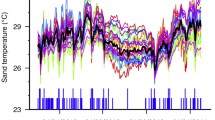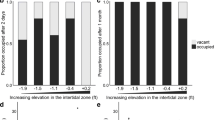Abstract
Sand and nest temperatures were monitored during the 2002–2003 nesting season of the green turtle, Chelonia mydas, at Heron Island, Great Barrier Reef, Australia. Sand temperatures increased from ∼ 24°C early in the season to 27–29°C in the middle, before decreasing again. Beach orientation affected sand temperature at nest depth throughout the season; the north facing beach remained 0.7°C warmer than the east, which was 0.9°C warmer than the south, but monitored nest temperatures were similar across all beaches. Sand temperature at 100 cm depth was cooler than at 40 cm early in the season, but this reversed at the end. Nest temperatures increased 2–4°C above sand temperatures during the later half of incubation due to metabolic heating. Hatchling sex ratio inferred from nest temperature profiles indicated a strong female bias.



Similar content being viewed by others
References
Bjorndal KA, Bolten AB (1992) Spatial distribution of green turtle (Chelonia mydas) nests at Tortuguero, Costa Rica. Copeia 1992:45–53
Booth DT, Astill K (2001) Temperature variation within and between nests of the green sea turtle, Chelonia mydas (Chelonia: Cheloniidae) on Heron Island, Great Barrier Reef. Aust J Zool 49:71–84
Booth DT, Burgess E, McCosker J, Lanyon JM (2004) The influence of incubation temperature on post-hatching fitness characteristics of turtles. Int Congr Ser 1275:250–257
Broderick AC, Godley BJ, Hays GC (2001) Metabolic heating and the prediction of sex ratios for green turtles (Chelonia mydas). Physiol Biochem Zool 74:161–170
Bustard R (1972) Sea turtles, natural history and conservation. Collins, London-Sydney
Georges A, Limpus CJ, Stoutjesdijk C (1994) Hatchling sex in the marine turtle Caretta caretta is determined by proportion of development at a temperature, not daily duration of exposure. J Exp Zool 270:432–444
Georges A, Doody JS, Beggs K, Young JE (2004) Thermal models of TSD under laboratory and field conditions. In: Valenzuela N, Lance V (eds) Temperature dependent sex determination in vertebrates. Smithsonian Books, Washington D.C., pp 79–89
Girondot M, Delmas V, Rivalan P, Courchamp F, Prevot-Julliard A-C, Godfrey MH (2004) Implications of temperature-dependent sex determination for population dynamics. In: Valenzuela N, Lance V (eds) Temperature dependent sex determination in vertebrates. Smithsonian Books, Washington D.C., pp 148–155
Godley BJ, Broderick AC, Downie JR, Glen F, Houghton JD, Kirkwood I, Reece S, Hays GC (2001) Thermal conditions in nests of loggerhead turtles: further evidence suggesting female skewed sex ratios of hatchling production in the Mediterranean. J Exp Mar Biol Ecol 263:45–63
Godley BJ, Broderick AC, Glen F, Hays GC (2002) Temperature-dependent sex determination of Ascension Island green turtles. Mar Ecol Prog Ser 226:115–124
Limpus CJ, Reed P, Miller JD (1983) Islands and turtles. The influence of choice of nesting beach on sex ratio. In: Baker JT, Carter RM, Sammarco PW, Stark KP (eds) Proceedings: inaugural Great Barrier Reef Conference. James Cook University Press, Townsville, pp 397–402
Miller JD (1985) Embryology of marine turtles. In: Gans C, Billett F, Maderson PFA (eds) Biology of the reptilia, vol. 14 Development A. John Wiley and Sons, New York, pp 269–328
Miller JD, Limpus CJ (1981) Incubation period and sexual differentiation in the green turtle Chelonia mydas. In: Banks C, Martin A (eds) Proceedings of the Melbourne Herpetological Symposium. The Zoological Board of Victoria, Parkville, pp 66–73
Mrosovsky N (1994) Sex-ratios of sea turtles. J Exp Zool 270:16–27
Mrosovsky N, Bass A, Corliss LA, Richardson JI, Richardson TH (1992) Pivotal and beach temperatures for hawksbill turtles nesting in Antigua. Can J Zool 70:1920–1925
Spotila JR, Standora EA, Morreale SJ, Ruitz GJ (1987) Temperature dependent sex determination in green turtle (Chelonia mydas): effects on the sex ratio on a natural nesting beach. Herpetologica 43:74–81
Yntema CL, Mrosovsky N (1982) Critical periods and pivotal temperatures for sexual differentiation in logger-head sea turtles. Can J Zool 60:1012–1016
Acknowledgments
We thank two reviewers and the editorial staff at Coral Reefs for suggesting many improvements and for statistical advice. We thank the staff of Heron Island Research Station for logistical assistance and for meteorological data. This work was carried out under the University of Queensland Animal Ethics Approval Number ZOO/ENT/231/02/URG/H and Queensland Parks and Wildlife Service Scientific Purposes Permit WITK00399002.
Author information
Authors and Affiliations
Corresponding author
Additional information
Communicated by Biology Editor M.I. McCormick
Rights and permissions
About this article
Cite this article
Booth, D.T., Freeman, C. Sand and nest temperatures and an estimate of hatchling sex ratio from the Heron Island green turtle (Chelonia mydas) rookery, Southern Great Barrier Reef. Coral Reefs 25, 629–633 (2006). https://doi.org/10.1007/s00338-006-0135-4
Received:
Accepted:
Published:
Issue Date:
DOI: https://doi.org/10.1007/s00338-006-0135-4




